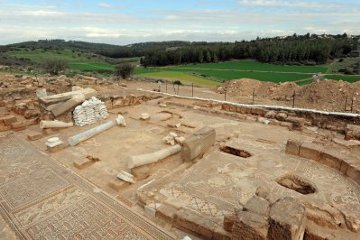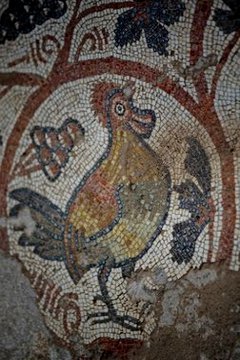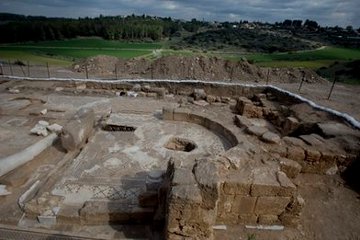Zechariah Found at Last
Everyone loves something for nothing, whether it is a "two for the price of one" offer at the supermarket or a coin winking up at us from the gutter. It is this which drives many Western people to invest in electronic devices and spend fruitless hours "metal detecting" in the hope that they will discover treasure - and it is the same motivation which leads people in the East to head for the nearest tel, trowel in hand, when money begins to run short at home.
One can sympathise with this universal desire to obtain unearned income, but what both western metal detectorists and eastern grave robbers ignore is that their always dishonourable and frequently illegal scrabblings after treasure are doing more harm than they can imagine. It is as if someone stole the Mona Lisa in order to get the gilt off its frame, or broke up the Venus de Milo to build a stone wall.
Imagine if you were to walk past an antiquities shop and see the death mask of Tutankhamun for sale in the window. You would, of course, be impressed by the amount of gold, by the evidence of fine craftsmanship, by the sheer beauty of the object. You go inside the shop and ask the dealer what it is?
"Dunno," he replies (in Arabic, of course).
"How old is it?" you ask.
"Dunno."
"Who is it?"
"Dunno."
"Where was it found?"
"Dunno, gov. I bought it off this bloke, see? Said it had fallen off the back of a lorry."
It is the fact that the death mask was found in a tomb, on a mummy, accompanied by all those other objects, surrounded by the romantic story of the boy-king and his heretic father, that gives the death mask its unique and compelling attraction! If it had been found by grave robbers and disposed of anonymously - or even worse, melted down for its gold! - the world would be so much the poorer.
Yet the ignorant continue to despoil the ancient and in order to curb their activities, Israel has an Antiquities Robbery Prevention Unit, whose current head is Amir Ganor. Late last year (2010) Ganor and his team became aware of coins coming onto the antiquities market which had no legal provenance. Clues were uncovered, leads followed up, in the best Sherlock Holmes tradition and their enquiries directed them to an ancient mound twenty-five miles south-west of Jerusalem called Khirbet Midras.
Sure enough, when they visited the site they discovered the tell-tale pockmarks where the illicit diggers had been at work hunting for "antikas" they could sell for a few shekels in Jerusalem - to dealers who would sell them on for tens if not hundreds of shekels to unscrupulous tourists. They also found the upper part of a stone doorway sticking out above the earth.

| |
| A general view of the recently excavated church at Khirbet Midras. |
There is, unfortunately, only one way to stop tomb robbers and that is to excavate the tombs yourself and leave nothing for them to rob. Ganor turned from policeman to archaeologist and began to excavate the site. Almost immediately they found that they had discovered a substantial building dating from the early Byzantine period around AD 500. At first they thought that it might be a synagogue - always exciting for a Jew - but then they uncovered some blocks of stone on which crosses were carved and realised that they had, in fact, discovered a church.
The floor was littered with fallen marble pillars and beyond them they uncovered the outline of the apse which stands at the western end of all ancient churches. As they cleared the earth in what was the "holy of holies" of the church, the place where the sacred mysteries were performed, they came down to floor level and gasped. Each stroke of the brush or thrust of the trowel uncovered more and more of a splendid mosaic floor 30 feet long and filling the entire width of the building.

| |
| Among the birds depicted in the mosaic floor of the church is this rooster caught, it would appear, in the act of crowing. |
In brilliant colours, the floor depicted a variety of plants and animals - lions, foxes, fish, peacocks, even a domestic rooster - set among a carpet of geometric shapes. It is, Ganor told the press, "one of the most beautiful mosaics to be uncovered in Israel in recent years."
Unfortunately, right in the middle of the apse there was a large hole in the floor right in the position where the altar should have stood. Digging down into this hole the archaeologists discovered that there was a burial chamber underneath the church - indeed, the church appeared to have been built over the chamber. There was also a network of tunnels which they dated to the second century AD and which may have been used by Jewish freedom fighters (aka terrorists, depending on your point of view) fighting against the Romans during the Bar Kokhba revolt in AD 132.
Naturally Ganor was curious to know why a church should have been built at this spot and who was the saint or martyr supposedly buried underneath it. Unfortunately the archaeologists haven't found any inscriptions, not even graffiti scrawled on the walls - there's never a vandal around when you want one! However in such cases there is a useful tool: the mosaic mab at Madeba.

| |
| Detail of the apse area of the newly discovered church showing the hole where the altar once stood. |
This remarkable map in Jordan suffers from two problems. The first is that it is damaged and often the very place in which you are interested is missing. The second is that it was made by artists, not surveyors, and is not to scale nor entirely accurate in its placement of locations. Nevertheless, a careful examination of the map and triangulating between known locations, does appear to indicate that in the place where this church has been found there was an ancient church and shrine - to the prophet Zechariah!
Unfortunately the new discovery is not likely to feature on our tours in the near future, for the Israeli Antiquities Authority intends to cover up the site in a couple of weeks in order to preserve it until such time as the funds can be found to restore and rennovate it and open it properly to tourists. As the building is a church, rather than the hoped for synagogue, finding the money is likely to take some considerable time.
© Kendall K. Down 2011





